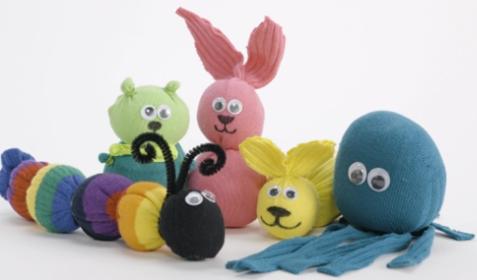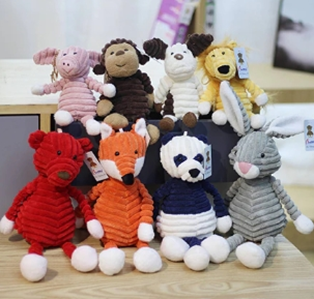How to Make Stuffed Toys: A Beginner’s Guide
Making stuffed toys is an enjoyable and rewarding activity that offers a unique opportunity to create personalized gifts and develop sewing skills. How to make stuffed toys from scratch allows for creativity and imagination to shine, whether you're a beginner or an experienced crafter. These handmade toys are not only fun to make but also serve as thoughtful, one-of-a-kind gifts for loved ones. This guide will provide all the essential steps, tools, and tips you need to start creating your own stuffed toys. From choosing the right materials to the sewing and stuffing process, you'll learn everything you need to craft delightful, cuddly creations.

What You’ll Need to Make Stuffed Toys
Before you begin, gathering the right materials is essential to ensuring a smooth and enjoyable crafting process. You’ll need fabric such as cotton, fleece, or felt, which are soft and durable, making them perfect for stuffed toys. Patterns are crucial for guiding your cuts, and you can either draw your own or use free downloadable patterns available online. Essential sewing supplies include needles, thread, scissors, pins, and optionally, a sewing machine for quicker assembly. For the inside of your toy, you’ll need stuffing, such as polyester fiberfill or cotton. Don’t forget marking tools like fabric markers or chalk for precision, and embellishments such as safety eyes, buttons, ribbons, or any accessories to add personality to your creation.
Step-by-Step Guide: How to Make Stuffed Toys
Designing the Toy
The first step in creating a stuffed toy is deciding on the design. Start by sketching your idea on paper, considering its shape, size, and features. Keep the design simple to ensure that the sewing process will be manageable, especially if you're a beginner. Think about the toy’s unique characteristics, such as the face, ears, arms, and legs. Adding smaller details like buttons for eyes or embroidery for a mouth can give the toy more personality. Once the design is clear, trace it onto paper to create a pattern for each part of the toy. This pattern will be the template that guides your fabric cutting.
Cutting the Fabric
After you've designed and traced the patterns for your stuffed toy, it's time to cut the fabric. Lay your fabric flat and pin the paper patterns to it. Carefully cut around each pattern, leaving a small seam allowance (around 1/4 inch) around the edges. This extra fabric ensures that there’s enough material to sew the pieces together without causing gaps or fraying. Pay close attention to accuracy, especially around corners or intricate parts of the design, as uneven pieces may lead to difficulties in sewing and assembling the toy. Take your time, as precision during cutting is key to a clean, polished finished toy.

Sewing the Pieces Together
Once you’ve cut all the fabric pieces for your stuffed toy, begin the sewing process. Place two fabric pieces with their right sides facing each other, making sure they align properly. Pin them together to prevent shifting during sewing. Using either a sewing machine or hand sewing with a needle and thread, sew along the edges, leaving an opening at the top for turning the toy right-side-out and for stuffing. Make sure your stitches are even and secure, but not too tight. Once you finish sewing, trim any excess fabric along the seam allowance, ensuring the edges are neat. This will help the toy retain its shape.
Stuffing and Closing the Toy
The final steps of making your stuffed toy involve stuffing it with fiberfill and closing the seams. Start by gently stuffing the toy through the opening you left while sewing. Make sure to push the stuffing into every corner and edge to create a smooth and even shape, avoiding lumps. Gradually add stuffing, checking the firmness and shape along the way to ensure the toy feels plush but not overly stiff. After you're satisfied with the stuffing, fold the seam allowance into the opening and use a ladder stitch to close it up neatly. Tie off the thread securely, and your toy is complete.
Common Mistakes to Avoid When Making Stuffed Toys
Incorrect Stitching
A frequent issue when making stuffed toys is improper stitching, which can affect the toy’s appearance and durability. If your stitches are uneven or too tight, the toy may look messy, or the fabric may become damaged over time. Make sure to use neat, consistent stitches when joining fabric pieces together. Practice basic hand stitches like backstitch or ladder stitch, as these will provide strong and secure seams. Additionally, avoid leaving gaps between stitches, as this could lead to the seams opening and the stuffing leaking out. Using a sewing machine can help achieve even, consistent stitches, especially for larger projects.
Overstuffing or Understaffing
Stuffing is a crucial part of creating a well-proportioned, plush toy. If you overstuff, the fabric may stretch too tightly, causing the seams to strain or burst. It can also result in a toy that feels too firm, rather than cuddly. On the other hand, understaffing can make the toy look limp and deflated. It's important to add stuffing gradually, testing the firmness of the toy as you go. Aim for a balance that gives the toy its desired shape while remaining soft enough to cuddle. Carefully check for any areas that need more stuffing for an even feel throughout the toy.
Skipping the Proper Seams
One common mistake when making stuffed toys is skipping or neglecting the proper seams. Always leave a seam allowance when cutting the fabric, as this extra material ensures you have enough room for sewing the pieces together. Additionally, be sure to secure the final seam with an invisible stitch, such as a ladder stitch, to make it discreet and sturdy. Skipping these steps can lead to a toy that’s either poorly stitched or prone to unraveling. Taking the time to use proper seams ensures your toy holds together and retains its shape, contributing to both its durability and overall look.
How to Customize Stuffed Toys
Customization is a fun and personal way to make stuffed toys even more special. You can add a unique touch by using different fabrics within a single toy, creating fun patterns or a patchwork design. Fabric paints and embroidery allow you to add names, initials, or even intricate designs such as flowers or stars. Customize the features of the toy, such as adding safety eyes, embroidery for the face, or making clothes for them. Accessories like bows, hats, glasses, or scarves can be added to reflect a specific theme, hobby, or personality. Customizing stuffed toys offers endless possibilities, allowing you to create a truly one-of-a-kind gift.
Conclusion
Making stuffed toys is a delightful and creative hobby that provides a rewarding experience. Whether you’re crafting for fun, making gifts, or learning new sewing skills, how to make stuffed toys is a fulfilling process that brings both joy and satisfaction. With the proper materials, time, and care, you can create beautiful, personalized stuffed toys that will be cherished for years. This guide has covered the essential steps and tips to help you get started, but don’t hesitate to experiment with different designs and techniques. Let your imagination guide you as you bring your cuddly creations to life.
FAQ
How long does it take to make a stuffed toy?
The time it takes to make a stuffed toy depends on the complexity of the design and your sewing skills. For beginners, it may take several hours to a full day from start to finish. Simpler designs can be completed in a shorter time, while more elaborate toys will naturally take longer.
Can I make stuffed toys without sewing?
Yes, it’s possible to make no-sew stuffed toys using fabric glue or by utilizing methods like tying or knotting the fabric. However, stitched toys tend to be more durable and have a more professional finish. Beginners are encouraged to learn basic sewing skills to achieve the best results.
What type of fabric is best for making stuffed toys?
The best types of fabric for making stuffed toys include cotton, fleece, and felt. Cotton is easy to work with and comes in a wide variety of patterns and colors. Fleece is soft and cozy, perfect for cuddle-friendly toys. Felt is excellent for smaller, detailed work and doesn’t fray when cut. Experiment with different fabrics to find your favorite.
